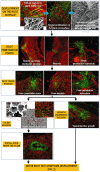Developing tools to unravel the biological secrets of Rosellinia necatrix, an emergent threat to woody crops
- PMID: 22014332
- PMCID: PMC6638663
- DOI: 10.1111/j.1364-3703.2011.00753.x
Developing tools to unravel the biological secrets of Rosellinia necatrix, an emergent threat to woody crops
Abstract
White root rot caused by Rosellinia necatrix is one of the most destructive diseases of many woody plants in the temperate regions of the world, particularly in Europe and Asia. Recent outbreaks of R. necatrix around the globe have increased the interest in this pathogen. Although the ecology of the disease has been poorly studied, recent genetic and molecular advances have opened the way for future detailed studies of this fungus.
Taxonomy: Rosellinia necatrix Prilleux. Kingdom Fungi; subdivision Ascomycotina; class Euascomycetes; subclass Pyrenomycetes; order Sphaeriales, syn. Xylariales; family Xylariaceae; genus Rosellinia.
Identification: Fungal mycelium is present on root surfaces and under the bark, forming mycelium fans, strands or cords. A typical presence of pear-shaped or pyriform swellings can be found above the hyphal septum (with diameters of up to 13 µm). Sclerotia are black, hard and spherical nodules, several millimetres in diameter. Black sclerotia crusts may also form on roots. On synthetic media, it forms microsclerotia: irregular rough bodies composed of a compact mass of melanized, interwoven hyphae with no differentiated cells. Chlamydospores are almost spherical (15 µm in diameter). Synnemata, also named coremia (0.5-1.5 mm in length), can be formed from sclerotia or from mycelial masses. Conidia (3-5 µm in length and 2.5-3 µm in width) are very difficult to germinate in vitro. Ascospores are monostichous, situated inside a cylindrical, long-stalked ascus. They are ellipsoidal and cymbiform (36-46 µm in length and 5.5-6.3 µm in width).
Host range: This fungus can attack above 170 different plant hosts from 63 genera and 30 different families, including vascular plants and algae. Some are of significant economic importance, such as Coffea spp., Malus spp., Olea europaea L., Persea americana Mill., Prunus spp. and Vitis vinifera L.
Disease symptoms: Rosellinia necatrix causes white (or Dematophora) root rot, which, by aerial symptoms, shows a progressive weakening of the plant, accompanied by a decline in vigour. The leaves wilt and dry, and the tree can eventually die. White cottony mycelium and mycelial strands can be observed in the crown and on the root surface. On woody plant roots, the fungus can be located between the bark and the wood, developing typical mycelium fans, invading the whole root and causing general rotting.
Disease control: Some approaches have been attempted involving the use of tolerant plants and physical control (solarization). Chemical control in the field and biological control methods are still under development.
© 2011 The Authors. Molecular Plant Pathology © 2011 BSPP and Blackwell Publishing Ltd.
Figures



Similar articles
-
Weed Roots Facilitate the Spread of Rosellinia necatrix, the Causal Agent of White Root Rot.Microbes Environ. 2019 Sep 25;34(3):340-343. doi: 10.1264/jsme2.ME19013. Epub 2019 Jun 20. Microbes Environ. 2019. PMID: 31217362 Free PMC article.
-
First Report of White Root Rot of Japanese Serissa Caused by Rosellinia necatrix in Taiwan.Plant Dis. 2007 Nov;91(11):1512. doi: 10.1094/PDIS-91-11-1512B. Plant Dis. 2007. PMID: 30780762
-
Transcriptome analysis of the fungal pathogen Rosellinia necatrix during infection of a susceptible avocado rootstock identifies potential mechanisms of pathogenesis.BMC Genomics. 2019 Dec 26;20(1):1016. doi: 10.1186/s12864-019-6387-5. BMC Genomics. 2019. PMID: 31878883 Free PMC article.
-
Phymatotrichum (cotton) root rot caused by Phymatotrichopsis omnivora: retrospects and prospects.Mol Plant Pathol. 2010 May;11(3):325-34. doi: 10.1111/j.1364-3703.2010.00616.x. Mol Plant Pathol. 2010. PMID: 20447281 Free PMC article. Review.
-
Viruses of the white root rot fungus, Rosellinia necatrix.Adv Virus Res. 2013;86:177-214. doi: 10.1016/B978-0-12-394315-6.00007-6. Adv Virus Res. 2013. PMID: 23498907 Review.
Cited by
-
Draft Genome Sequence of the Rhizobacterium Pseudomonas chlororaphis PCL1601, Displaying Biocontrol against Soilborne Phytopathogens.Genome Announc. 2017 Apr 6;5(14):e00130-17. doi: 10.1128/genomeA.00130-17. Genome Announc. 2017. PMID: 28385848 Free PMC article.
-
Biocontrol potential of Trichoderma-derived chitinase: optimization, purification, and antifungal activity against soilborne pathogens of apple.Front Fungal Biol. 2025 Jul 24;6:1618728. doi: 10.3389/ffunb.2025.1618728. eCollection 2025. Front Fungal Biol. 2025. PMID: 40787606 Free PMC article.
-
Rosellinia necatrix infection induces differential gene expression between tolerant and susceptible avocado rootstocks.PLoS One. 2019 Feb 14;14(2):e0212359. doi: 10.1371/journal.pone.0212359. eCollection 2019. PLoS One. 2019. PMID: 30763398 Free PMC article.
-
Expression of the β-1,3-glucanase gene bgn13.1 from Trichoderma harzianum in strawberry increases tolerance to crown rot diseases but interferes with plant growth.Transgenic Res. 2015 Dec;24(6):979-89. doi: 10.1007/s11248-015-9895-3. Epub 2015 Jul 16. Transgenic Res. 2015. PMID: 26178245
-
Organic amendments to avocado crops induce suppressiveness and influence the composition and activity of soil microbial communities.Appl Environ Microbiol. 2015 May 15;81(10):3405-18. doi: 10.1128/AEM.03787-14. Epub 2015 Mar 13. Appl Environ Microbiol. 2015. PMID: 25769825 Free PMC article.
References
-
- Abe, T. and Kono, M. (1953) Studies on the white root rot of tea bush I. Sci. Rep. Saikyo Univ. Agric. 5, 93–105.
-
- Abe, T. and Kono, M. (1955) Studies on the white root rot of tea bush. III: on the effect on composants of culture media to the fungal growth, and the phytotoxicity of the filtrate of liquid media used by the fungus. Sci. Rep. Saikyo Univ. Agric. 7, 49–56.
-
- Abe, T. and Kono, M. (1957) Studies on the white root rot of tea bush. IV: on the toxicities of cultural filtrate of the fungus. Sci. Rep. Saikyo Univ. Agric. 8, 74–80.
-
- Agarwala, R.K. and Sharma, V.C. (1966) White root‐rot disease of apple in Himachal Pradesh. Indian Phytopathol. 29, 82–86.
-
- Agarwala, S.C. and Sharma, C.P. (1976) Pot sand culture technique for the study of mineral element deficiency under Indian conditions. Geophytology, 6, 356–367.
Publication types
MeSH terms
LinkOut - more resources
Full Text Sources
Miscellaneous

